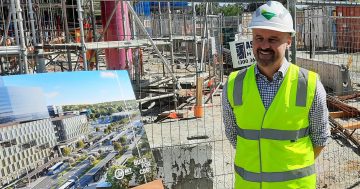
The recently released business case for light rail Stage 2 showed the major project had a benefit-cost ratio of less than 1. Photo: Michelle Kroll.
The Chief Minister has stated benefit-cost ratios are “not important at all” when it comes to choosing Canberra’s infrastructure projects.
Andrew Barr made the statement during Budget Estimates when asked by Opposition Leader Leanne Castley how important it was for ratios to exceed ‘1’ for major projects.
“[It’s] not important at all,” he said.
“If you just made every decision on infrastructure on that basis, then … there wouldn’t be many projects that would proceed.”
Mr Barr said the ratios were just one element of decision-making and that while the ratios were required for all ACT Tier 1 projects, they weren’t required for Tier 2 projects.
BCRs (business-cost ratios, also known as cost-benefit analysis or CBAs) are a financial metric used to assess how economically viable a project or investment is.
According to Infrastructure Australia, BCRs are “the most robust tool for economic appraisal”.
“It measures the implications of interventions for the welfare and wellbeing of communities by analysing the social, economic and environmental impacts over their operational life,” its website stated.
A ratio greater than 1 suggests the benefits of a project outweigh the costs, while a BCR less than 1 indicates that costs will exceed benefits.
When pressed by Ms Castley how many projects the ACT Government had supported that had a BCR less than 1, Mr Barr responded that “most projects” would have that outcome.
He argued there was a good reason why obtaining a BCR above 1 wasn’t a necessity.
“You would never fund a hospital or a school, most likely, [as] they don’t generate any revenue, they cost you more,” Mr Barr said.
“There is still a process to run through.”
Ms Castley said this “revelation” showed that many of the government’s major projects “don’t stack up”.
“ACT Labor have not delivered a surplus in a decade; the deficit for the financial year just gone was $1.3 billion in the red and now they tell us that they don’t need to listen to any cost-benefit analysis when it comes to spending ACT taxpayers’ money,” she said.
“Spending billions of dollars on major projects without proper evaluation is a recipe for waste and mismanagement.”
Ms Castley also used Infrastructure Australia’s publication of business cases to question why the ACT Government doesn’t publish theirs before procurement is completed.
Mr Barr responded that the Commonwealth entity isn’t involved in procurement and that there needed to be some “competitive tension” when projects are put out to tender.
“Common sense to me says don’t tell the market before you even go and engage with them exactly the price and the provision that you’ve made [for the project],” he said.
“I think we do need, in the procurement stage, the ability to approach the market without revealing all of our hand.”
Once procurements are completed, contracts are published on a public register.
Things became heated between Mr Barr and Ms Castley during Estimates when the Chief Minister was asked why business cases couldn’t be compiled and published once contracts had been signed.
Mr Barr argued it would also be “very time-consuming”.
“The question is, with our limited resources, do we want to tie up the time of a very small team in doing a whole bunch of reporting and what particular benefit?” he said.
“I think there is an appropriate [project cost] threshold to set, and then the question ultimately would be: what benefits?”
Ms Castley interjected that it would give an “understanding [of] how the government is spending [taxpayer] money.”
“Sure, and that is a legitimate argument,” Mr Barr responded.
“But equally, you can see these processes ending up in administration for the sake of it … and just increasing the cost for everything.
“A balance would need to be struck.”





















